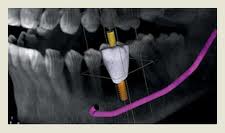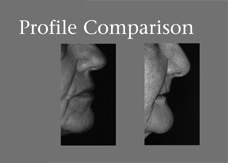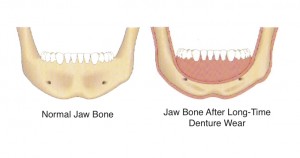Header logo
header top contact widget
Dentures/Partial Dentures
Wear Dentures? The Problems They Cause You May Not See.
Posted on Aug 24, 2016 by William J. Claiborne, DDS MS
As a Periodontist, my advanced training and skills are ideal for people who have any stage of periodontal (gum) disease as well as those who are seeking dental implants to replace missing teeth.
When it comes to dental implants, I often see patients who have worn dentures for many years. Most are frustrated by the uncomfortable rubbing and inability to eat foods they love.
Patients are perplexed as to why their once-secure denture no longer stays in place, even with the aid of denture adhesives and pastes. For those who have had their denture relined, most are surprised when the denture begins to slip and wobbly yet again.
Unfortunately, when many adults first agree to wearing a denture they are not told what lies ahead. The problem is not obvious since it occurs underneath the gum tissue. The denture is not expanding or changing shape. The change is actually occurring with your jaw bone.
When natural tooth roots are removed, the jaw bone that once held them no longer receives the stimulants that kept it healthy. In only a year or so, the jaw bone will begin to shrink. This decline in mass also causes changes in facial appearance, such as deep wrinkles around the mouth, a sunken in mouth, and jowls.
With each passing year of wearing a denture, the process of bone loss continues. The ‘ridge’ your denture was custom-designed to contour flattens out. Relines can reshape the denture to accommodate some of the change. However, as the bone continues to decline, the denture’s fit loosens again.
The pressure of wearing a denture merely accelerates the rate of bone loss. For denture wearers who sleep in their denture, the 24-7 pressure accelerates the pace of bone loss even more.
Not being able to eat and fear of embarrassment are common complaints of denture wearers. The solution is dental implants. Dental implants restore the ability to bite and chew comfortably while halting bone loss by recreating the presence of tooth roots.
When people select dental implants to replace an unstable denture, their ability to smile, laugh and eat comfortably and confidently is restored. After all, eating a healthy diet, socializing with friends and family, and feeling confident are essential to a healthy, happy life.
Call 828-274-9440 to schedule a consultation. During this, I’ll explain the type of implants that may be best for your needs and goals. We can also discuss estimated costs and payment options.
Problems Experienced When Jaw Bone Shrinks
Posted on Jul 05, 2016 by William J. Claiborne, DDS MS
When natural teeth are lost, there are a number of ways to restore the appearance of your smile. However, there is only one way to maintain dependable, secure biting and chewing – Dental Implants. Here’s why…
Natural tooth roots provide stimulation to the jaw bone, which preserves its ability to maintain a healthy mass. When tooth roots are missing, the jaw bone loses the stimulation needed to keep blood flow active. Over time, this results in ‘resorption,’ or a decline in bone mass.
The resorption process causes the gum ridge to flatten. The pressure on the gum ridge from wearing dentures actually accelerates the rate of bone loss. For those who sleep in their dentures, this 24/7 pressure speeds the rate of bone loss even more.
When a denture is first made, it is designed to conform to the unique contours of the bone ‘arch’ where tooth roots were once positioned. The reason that denture wearers commonly experience movement or slips is because the denture’s foundation is shrinking. Even with the help of adhesives or pastes, this dwindling foundation means a denture is likely to move while eating.
A new denture may fit securely for the first five years. However, as the jaw bone continues to lose height, relines may help on a temporary basis. As bone loss continues, relines to your denture or partial will need to be done at more frequent intervals each time.
One year after natural teeth have been extracted, denture wearers average losing about 25 percent of this bone ridge. After three years, the average decline in bone is approximately 60 percent. Biting becomes risky. Chewing is more difficult. The biting force of natural teeth is about 250 lbs. while an average denture wearer is able to apply about 5 lbs. of force.
Want to see the extent of resorption you’ve experienced? Begin by looking in the mirror without your denture in place. Your mouth may appear sunken-in with your chin more pointed than before tooth loss. Other signs of bone loss include deep wrinkling around the mouth, the corners of the mouth turning downward (even when smiling), and jowls from the detachment of facial muscles.
There is a solution to the ongoing challenges of bone loss. Today’s implant dentistry offers excellent options to replace missing teeth and overcome the problems associated with bone loss (even when bone loss is severe). Implant systems such as All-On-4 can be positioned in minimal bone using just four implants. Placed at specific angles, All-On-4 can support a full, non-removable denture in minimal bone.
There are many reasons so many adults are now choosing Dental Implants for tooth replacement. They halt the process of bone loss while restoring chewing comfort and confidence when speaking or laughing.
A Periodontist specializes in the treatment of gum tissues as well as the diagnosis and placement of Dental Implants. Although the failure rate of Dental Implants is rather low, having a successful outcome can greatly depend on the Doctor who selects and places your implants.
Begin with a consultation by calling 828-274-9440. I’ll be happy to answer your questions and discuss our many comfort options, including Oral and I.V. Sedation.
Losing Teeth In Old Age Is NOT To Be Expected
Posted on Jun 27, 2016 by William J. Claiborne, DDS MS
With proper care, your natural teeth are designed to last your lifetime. And it is important that you do everything possible to keep your natural teeth.
It has been shown that denture wearers take more medications and have more gastrointestinal problems than those with their natural teeth. It should also be noted that denture wearers die ten years sooner, on average, than those who have their natural teeth.
The discomfort, inconvenience, and embarrassment experienced by most denture or partial wearers is due to a shrinking bone foundation. When natural tooth roots no longer exist in the jaw bone, the bone begins to shrink in depth and height. While denture adhesives may lessen the amount of movement for brief periods, difficulty when eating forces many people to resort to a diet of soft foods that dissolve easily in the mouth.
Bone loss also causes changes in one’s facial appearance, including deep wrinkling and a sunken-in appearance of the mouth. The corners of the mouth turn downward, even in a smile. Jowls form when facial muscles detach from the declining mass of jaw bone. This causes denture wearers to look far older than their actual age.
Because Dental Implants are held by the jaw, just as natural tooth roots, they halt the bone loss that dentures and partials actually accelerate. Another benefit is that Dental Implants are ‘self-supporting’ so it is not necessary to crown otherwise healthy, adjacent teeth to serve as a support for a bridge.
With proper selection and placement by an experienced Doctor, Dental Implants will provide as much pleasure and satisfaction as natural teeth. To discuss replacing a denture or partial, call 828-274-9440 to arrange a consultation appointment.
Different Types Of Dental Implants For Different Needs
Posted on Jun 06, 2016 by William J. Claiborne, DDS MS
A rose by another other name may still be a rose, but unlike Shakespeare’s writings, we know that roses come in all colors and sizes.
When the term ‘Dental Implant’ is used, it refers to the basic principle of this form of tooth replacement. Generically, the ‘implanted’ portion is what is positioned into your jaw bone to provide the same foundation as that afforded by natural tooth roots.
However, when considering the shape, size and even what is attached to an implant, the type of implant system can vary widely. For example, some implants are designed to be placed at unique angles to compensate for minimal bone depth. Some implant types are made to support a single tooth or bridge of several teeth while others are positioned to hold a full arch of teeth.
A successful outcome in Dental Implant treatment begins with the selection of the proper type of implant. In doing this, the doctor must have intricate knowledge of the specific type needed for the amount of bone mass present, location of implant sites, and the number of teeth to be supported.
Proper placement angles and depth are also important. The doctor placing the implants should also be skilled in the selection of the implant angles and positioning.
As a Periodontal specialist, my training includes the diagnosis and placement of Dental Implants. The most troubling thing I see in implant dentistry is when a patient opted for a “good deal” in Dental Implants and had a less-experienced doctor place an implant that must now be removed.
It’s amazing how seemingly minor miscalculations can become major issues that require implant removal. For example, an implant placed in the upper jaw in too-shallow bone can work its way into the sinus cavity. A lower implant in too little bone depth can reach a nerve that runs horizontally through the lower jaw.
In our office, it is a joy to see our patients who once struggled with dentures or partials complete Dental Implant treatment. They are able to resume a diet of healthy foods and feel confident in social settings. However, when we are referred an individual who learns his or her implant has ‘failed’ and must be removed, it is unfortunate.
As a dental specialist, I also must occasionally remove implants when a patient has not taken proper care of their oral hygiene at home. Oral bacteria can contribute to an infection that works its way into the bone surrounding the implant. In some cases, the only way to resolve the infection is to remove the implant.
While this is unfortunate, it is ultimately a choice the particular patient made that created the outcome. However, when a patient entrusts their implant treatment to a doctor and adheres to hygiene and healing guidelines, having an implant fail due to poor selection or placement is more than frustrating for dental specialists to witness.
If you are considering Dental Implants, increase your potential for a successful outcome by asking a Periodontist to join your dentist in team treatment. Many general dentists already have close relationships with Periodontists for implant placement and treatment of gum disease.
Feel free to discuss your specific needs and desires before you make your decision. Call (828) 274-9440 to schedule a consultation.
Recent Posts
Categories
Archives
- September 2024
- August 2024
- July 2024
- June 2024
- May 2024
- April 2024
- March 2024
- February 2024
- January 2024
- December 2023
- November 2023
- October 2023
- September 2023
- August 2023
- July 2023
- June 2023
- May 2023
- April 2023
- March 2023
- February 2023
- January 2023
- December 2022
- November 2022
- October 2022
- September 2022
- August 2022
- July 2022
- June 2022
- May 2022
- April 2022
- March 2022
- February 2022
- January 2022
- December 2021
- November 2021
- October 2021
- September 2021
- August 2021
- July 2021
- June 2021
- May 2021
- April 2021
- March 2021
- February 2021
- January 2021
- December 2020
- November 2020
- October 2020
- September 2020
- August 2020
- July 2020
- June 2020
- May 2020
- April 2020
- March 2020
- February 2020
- January 2020
- December 2019
- November 2019
- October 2019
- September 2019
- August 2019
- July 2019
- June 2019
- May 2019
- April 2019
- March 2019
- February 2019
- January 2019
- December 2018
- November 2018
- October 2018
- September 2018
- August 2018
- July 2018
- June 2018
- May 2018
- April 2018
- March 2018
- February 2018
- January 2018
- December 2017
- November 2017
- October 2017
- September 2017
- August 2017
- July 2017
- June 2017
- May 2017
- April 2017
- March 2017
- February 2017
- January 2017
- December 2016
- November 2016
- October 2016
- September 2016
- August 2016
- July 2016
- June 2016
- May 2016
- April 2016
- March 2016
- February 2016
- January 2016
- December 2015
- November 2015
- October 2015
- September 2015
- August 2015
- July 2015
- June 2015
- May 2015
- April 2015
- March 2015
- February 2015
- January 2015
- December 2014
- November 2014
- October 2014
- September 2014
- August 2014
- July 2014
- June 2014
- May 2014
- April 2014
- March 2014
- February 2014
- January 2014
- December 2013
- November 2013
- October 2013
- September 2013
- August 2013
- July 2013
- June 2013
- May 2013
- April 2013
- March 2013
- February 2013
- January 2013
- December 2012
- November 2012
- October 2012
- September 2012
- August 2012
- July 2012
- June 2012




